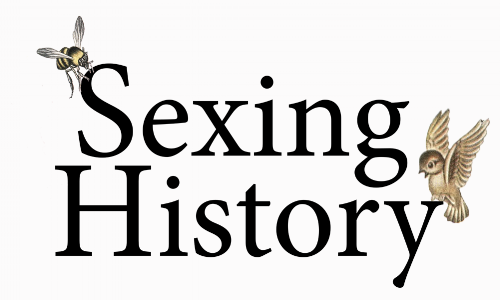Print
Samantha Borek, “The LGBTQ Movement Needs to Revisit Its Radical Past to Thrive“
”In this interview, Ferguson discusses the capitalist motivations for commodifying queerness and how the movement today can combat those motivations to return to a more intersectional movement.”
Mika Doyle, “Discovering My Sexuality After I Was 30 Was Confusing. This Is What I Wish I Knew“
”If there’s one thing I thought was 100 percent true about me, it was that I was straight. So when I started questioning whether I was bisexual in my early 30s, things started to get confusing, fast.”
Lori Fox, “Male Bush Workers Tell Us How They Respond to Sexism in the Industry“
”A number of men responded to a recent VICE article exposing sexual harassment in their line of work.”
Gillian A. Frank and Lauren Gutterman, “How Flight Attendants Organized Against Their Bosses to End 'Swinging Stewardesses' Stereotyping“
”Advertising the bodies of women employees was good for business. Though the ‘Fly Me’ campaign is now displayed on a number of websites, often as a glaring example of outdated sexism, at the time, ‘Fly Me’ reflected the widespread sexualization of flight attendants, which belied the harsh working conditions that these women negotiated while flying unfriendly skies.”
Amy Harmon, “How researchers are hitting back against sexism in science”
”Despite women assuming some of science’s most influential positions in recent years, experience and research has shown that harassment remains widespread – but innovative initiatives are helping.”
Rachel Charlene Lewis, “6 Queer Women and Femmes on the Iconic Outfit That Defined Their Sexuality“
”Many of us can also point to iconic fashion moments that made us feel things. Sexual things. Queer sexual things. In some cases, it just takes one outfit to make you realize you’re not as straight as you thought.”
Amy S. Patterson and Mark Daku, “On World AIDS Day, why the politics of AIDS is so important“
”Over more than a decade, we have interviewed dozens of AIDS advocates, health policymakers and people living with HIV and AIDS in South Africa, Uganda, Swaziland, Ghana, Zambia, Tanzania and the United States.”
Ben Paynter, “What LGBTQ people in the South say life is like for them“
”The LGBTQ Institute’s inaugural Southern Survey gives an insight into the lives of people living in places where government policies are often hostile toward them.”
Juliet Reid, “Black women are more vulnerable to Aids. So why aren’t they being helped?”
”In 2016, 79% of all women accessing HIV care in the UK were from the black, Asian and minority ethnic (BAME) community. Despite this outrageous reality, black women bear the brunt of funding cuts and are erased from mainstream HIV prevention messaging, leaving us more vulnerable still.”
Maria Sherman, “New Report Suggests Americans Want Gender Equality in the Workplace, Not So Much at Home“
”When it comes to gender equality, it’s unsurprising that two-thirds of Americans and three-quarters of millennials (the only generation to believe women are more equal at home than at work) lean egalitarian, but, as the New York Times points out, many believe ‘women should have the same opportunities as men to work or participate in politics, [but] they should do more homemaking and child-rearing’.”
Sarah Swedberg, “Silence and Noise: What AIDS Activism and Social Memory Can Teach Us“
”Since November 8, the friends I still have from that era who didn’t die or disappear have been reminding each other of our history of AIDS activism. With each new named cabinet appointment and each new tweet, we ask each other: ‘Remember when we changed the world?’ And we tell each other, ‘We didn’t want to do this again, but we can’.”
Stefan Vogler, “LGBTQ caravan migrants may have to ‘prove’ their gender or sexual identity at US border“
”LGBTQ asylum-seekers coming to the U.S. face a dramatically higher risk of violence due to homophobia and transphobia, particularly in immigration detention facilities, where they will likely be sent upon their arrival. A 2013 study by the Government Accountability Office found that transgender detainees account for 1 of every 5 confirmed sexual assaults in ICE custody, even though only 1 out of 500 detainees is trans.”
Avivah Wittenberg-Cox, “3 Reasons To Stop Calling Women 'Diverse'“
”Whoever came up with the idea of putting gender issues under the diversity umbrella? How did women, who are 50% of the population, control 60% of global spending, and represent 60% of university graduates, ever accept to be positioned as a ‘diversity’ demographic?”
Article Spotlight
"The forty years between 1960 and 2000 were among the most tumultuous decades in the history of gay male sexuality. For many gay men who came out in the period after the Stonewall riots in New York in 1969, the seventies were a golden age of sexual freedom. It was an era during which it became possible for American men to openly acknowledge their homosexuality and foster a sense of identity and community, and it also initiated a period of sexual experimentation. The advent of AIDS in 1981 changed all that."
Episode Spotlight
In the 1980s and 1990s, the San Francisco Metropolitan Community Church wrestled with profound questions: What does it mean to minister a gay church when so many in the congregation are dying from AIDS-related complications and grieving the recently dead? How do you have faith during an epidemic? And what does it mean to participate in communion in a community ravaged by a plague?
Books
Podcasts
This American Life’s “Little War on the Prairie”
”Growing up in Mankato, Minnesota, John Biewen says, nobody ever talked about the most important historical event ever to happen there: in 1862, it was the site of the largest mass execution in U.S. history. Thirty-eight Dakota Indians were hanged after a war with white settlers. John went back to Minnesota to figure out what really happened 150 years ago, and why Minnesotans didn’t talk about it much after.”
This American Life’s “But That’s What Happened”
”Stories of women in unsettling situations. When they try to explain what’s wrong, they’re told that they don’t understand—that there’s nothing unsettling about it.”








